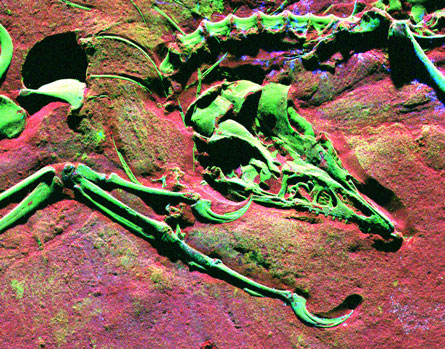The feathers preserved in a 150-million-year-old fossil of Archaeopteryx aren’t just casts of the primitive bird’s plumage, as paleontologists have long presumed: Amazingly, the structures retain chemical elements from the original feathers, a a new X-ray imaging technique reveals.

“People have been looking at these [feathers] a long time and thought they were just impressions, but there’s actually remains of soft tissue there,” says Roy Wogelius, a geochemist at the University of Manchester in England. He and his colleagues report their find online during the week of May 10 and in an upcoming Proceedings of the National Academy of Sciences.
The new technique is “opening up a new window into the chemistry of fossils,” says Derek Briggs, a paleontologist at Yale University.
In particular, the new images show high concentrations of phosphorus — an element found in abundance in the feathers of modern birds but not in the rocks surrounding the Archaeopteryx fossil — in the shafts and vanes of the fossil’s feathers. The key to the new finding is a recently developed imaging technique that illuminates the fossil with intense X-rays and causes trace elements in the fossil to fluoresce, says Wogelius. Previously, similar techniques that lit a surface with low-intensity X-rays required 24 hours to image each square centimeter of a surface, he notes. The new scheme, which uses high-intensity X-rays produced by a synchrotron to repeatedly scan an object, takes just 30 seconds to image the same area — a time savings that allows researchers to scan large objects in a short amount of time.
“It’s like using a spotlight versus a key-chain torchlight to illuminate a picture,” Wogelius explains. The technique can detect certain chemical elements at concentrations of just a few parts per million, he adds.
Besides the startling finding of phosphorus in the ancient fossil’s feathers, the team’s new analyses suggest that the fossil’s bones retain traces of their original zinc. Comparisons with the chemical composition of modern bird bones suggest that about half of the bones’ original zinc remains.
The chemical elements remained largely unaltered because both the Archaeopteryx bones and the sediments encasing them are rich in calcium.
“These are very exciting results,” Briggs says. “What this team has found simply wasn’t available by any other method.” Not only that, he notes: The new X-ray imaging technique is great because it’s nondestructive ─ which is particularly useful for exceptionally rare fossils such as Archaeopteryx, of which only 10 specimens have been found in the past century and a half.
“You can get all this spectral information without ever touching the fossil,” Briggs says.






